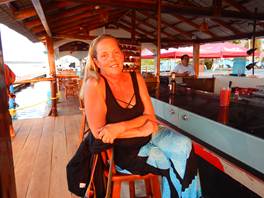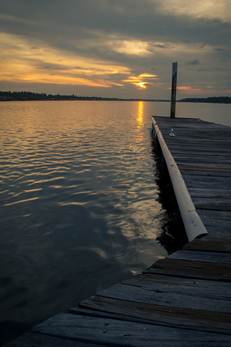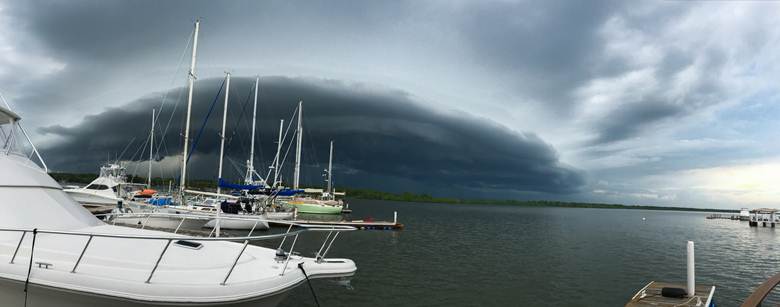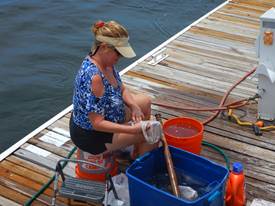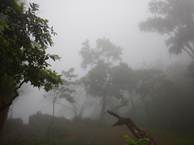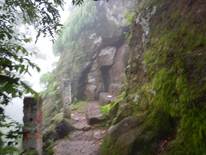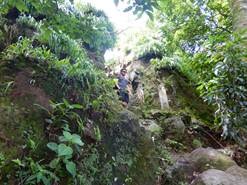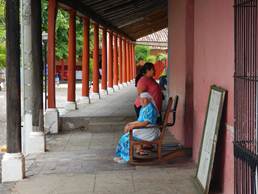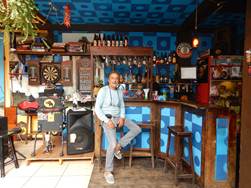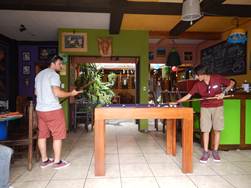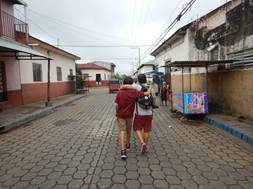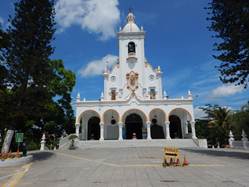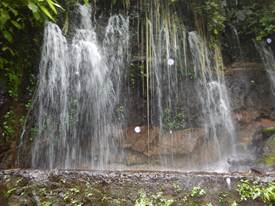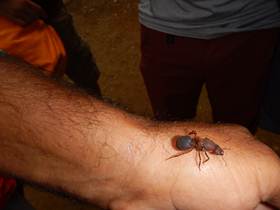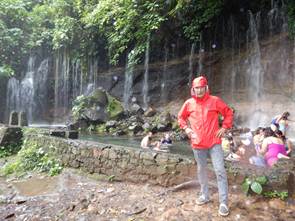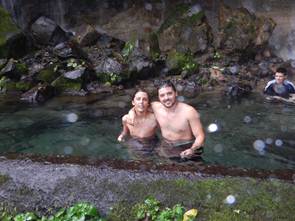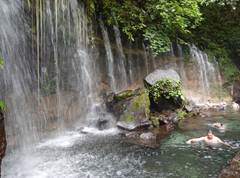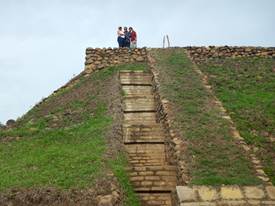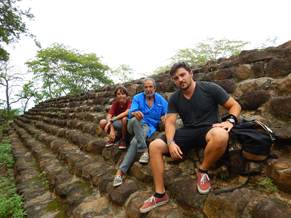Blog Post 42 - Chiapas to Costa Del Sol, El Salvador

NOTE TO READERS: I apologize for not posting for the past several weeks. I kind of lost my inspiration to do this and needed a hiatus. We have been traveling extensively throughout Central America and finding the time and the internet signal to post has been difficult. After reading some amazing blogs of some fellow cruisers and Worldschoolers of late and I have been encouraged and enlightened enough to continue writing. One of the problems with our blog host, mailasail is that you never know when someone has read the blog. Sometimes I feel like I am only writing for myself. In the future I will do my best to post bi-weekly. If you are reading this please send me an email and let me know what you think. teresanersesyan {CHANGE TO AT} gmail {DOT} com Blog Post 42 – Chiapas to Costa Del Sol, El Salvador 5/25/16 – 6/12/16 13.18.07N – 88.53.51W After Daniels graduation in Long Beach we returned to the boat. It was great to have all 4 of us together again... We spent the weekend getting the boat ready and provisioning. We planned to leave for El Salvador on Wednesday 5/25 in the late afternoon. We were going to skip Guatemala altogether and head straight for El Salvador. Guatemala is not a cruiser friendly place. They don’t seem to encourage boat travel to their country. It is a great place to travel by land but they don’t really have many ports or anchorages there that are cruiser friendly. There is one major port, Puerto Quetzal, but it is Guatemala’s only major port and it is choked with commercial traffic. It is also very expensive to check into the country via boat. It costs about $125 per person and there are numerous other fees to deal with. In other words they give cruisers lots of hoops to jump through. Unless you were planning on spending a lot of time there doing inland travel it is not worth the expense and the hassle, from our point of view. The run from Chiapas to Marina Bahia Del Sol was about 245 miles. We had 4 people for watches so it was an easy passage. Having Daniel on the boat makes a big difference. It really takes a heavy load off of Jirig, Daniel is strong and built like an ox and can do much of the heavy lifting. Nico was sooo stoked to have his big brother around again. We slipped right back into a well oiled routine. We ate well, laughed, played music and games and watched movies to pass the time. We saw lightning and thunderstorms all around us but we were able to avoid them. There was one snafu on our way out of marina Chiapas. We needed to go and fill our gas tanks before taking off. We were headed to the gas station through a narrow channel and as we were turning into the next channel we missed the navigation marker by about 4 feet and we ran aground. This happens to every cruiser at some point but this was a first for us. We have a huge boat, 52 ft and weighing 50 tons and it has a 6 ½ ft draft. I was always fearful of this happening as was Jirig, but when we imagined it happening we thought there would be a huge jolt. There wasn’t, it was very smooth. We were lucky that it was mud and silt underneath the hull and not a reef or rocks. All of a sudden the bow of the boat went up and the boat stopped. There was no noise, no jolt, no flying forward. Just a smooth stop, but we all knew immediately what had happened. The people from the gas station saw the whole thing and must have called the marina because within minutes we saw a small fishing boat that was sent to help us. There was no way that this small boat was going to dislodge us. They told us we would have to wait for the incoming high tide. We were lucky that we ran aground at low tide. We settled in to wait for the high tide. Jirig was not happy with waiting, he wanted to get out of the estuary by dark and you could see him pacing the deck trying to figure out a solution. All of a sudden he started barking orders. Get the dingy down. Get the stern anchor and 300 feet of rope. Get your gloves. He had devised his own plan to get us loose. He sent Daniel out in the dinghy with the stern anchor attached to 300 feet of line. He told him to place the anchor in the mud at the starboard side of the stern at about 250 feet away at a certain angle. He told him to wedge the anchor with his feet into the mud and stand on it. Then Jirig started to pull the anchor in with the winch. Within minutes you could feel the boat move, the bow come down and we were free and floating. All in all we were only delayed about 30 minutes and were able to get our gas and get out of the estuary before dark. There may have been some bruised egos but the boat was not damaged and we learned a good lesson. Never stray outside the navigation channel, not even a few feet! The Hotel & marina Bahia Del Sol is located in the Jaltepeque estuary. The entrance to the estuary is blocked by an ever shifting sandbar that is very dangerous to cross. You can only safely cross it at high tide and then only with an experienced local pilot boat guiding you in. We had been in email communication with the marina and the pilot boat for some time and were well versed, if apprehensive, about being guided across the sandbar and what to expect. The bar allows a very narrow entrance to the estuary of maybe 50ft and you have to ride an incoming wave to get in. We timed our arrival for dawn at the high tide. The pilot boat met us and began to guide us in. He advised that once we got going to gun the engines full throttle and get in as fast as possible. The pilot waited for a break in the swells and the perfect wave. Finally he gave us the signal and in we rode the wave across the bar. It was quite exhilarating but also terrifying. If the boat got caught sideways by the wave we might get rolled over. We would most likely right ourselves but it would be a shitstorm on the inside of the boat. Just a month before a small sailboat came in who did not have a reliable engine. When told to gun it by the pilot he engine sputtered and would not start. His boat got caught sideways and was hit by a wave. It went under and soon broke into pieces. The guy was lucky to get out alive. His boat is at the bottom of the ocean. We all held on tightly. Before we knew it it was all over and we were in and we could all breathe a sigh of relief. The Hotel & Marina Bahia Del Sol sits right inside the estuary. It is small, only about 20 slips. There is a nice hotel (by El Salvadoran standards) attached. We were met at the dock by immigration with the navy close by looking on. The check in procedures were simple and fast. They were much less dramatic than the greeting and search we got in Chiapas. The whole thing took about 30 minutes. We were starving so immediately went to the restaurant to chow down on a hot breakfast.
The plan, as it were, was to stay thru the weekend, get some rest and then head for Nicaragua. As we got to know some of our neighbors in the marina we started to hear the horror stories of heading south in the rainy season. Yes, the rainy season starts in Central America in late May or early June. It lasts just about as long as hurricane season does just a little further north. All of the cruisers we met in the marina were staying put for the duration of the season. We had been so preoccupied with getting out of the hurricane belt of Mexico that we had not given much thought to what was south of there. Once south of Chiapas you are clear of hurricanes. But Central America has its own version of hurricane season and it is called the “rainy season”. That is somewhat of a misnomer, it should be called lightening and thunder season. As we soon found out, 5 days out of 7 in the afternoon and early evening brings fierce thunderstorms that build throughout the day and then they unleash their fury in the way of rain, lightening and thunder right around sunset. We are southern Californians, what do we know of tropical storms? We are basically weather wimps. As a result we have no experience at all with bad weather or tropical storms. These storms build so fast and unleash so quickly, it really stuns you that the weather can change so fast, so dramatically. Everyone told us we were crazy to head south in the rainy season. They said that here in the estuary you are protected from the brunt of the storms and certainly the ocean swell that can come with them. They said the further south you go towards Nicaragua and Costa Rica, and especially Panama, the worse the storms and especially the lightening gets. We started to pause and reconsider our predicament. We had our hearts set on making it to Panama and going through the canal. It was something that Jirig and Daniel had been looking forward to for a long time. Jirig even had to make a serious promise to Daniel that we would not go through the canal without him and that we would wait for him to graduate from college and join us before doing so. The original plan was to be in Panama by May 1st. Daniel would fly to Panama after graduation to meet us and we would go through the canal together. But when our crew did not work out, then we decided to spend more time in Chiapas exploring inland and then waiting in Chiapas while Nico and I flew home for the graduation all conspired to delay us. We had made an appointment with the pilot to leave at 6AM the following morning on the high tide and we had checked out with customs and the harbor master. That night we sat down and had a serious family meeting. We looked at the weather for the trip and at the pilot charts for Nica, CR and Panama. It looked grim. Weather here is not in the form of cold fronts like we are used to on the West Coast of the US. You can see those systems coming for days. Here the water is very warm, and it generates intense heat that fuels thunderstorms. If you were to watch a radar screen (as we often find ourselves doing these days) over a few hours, at the beginning you would see nothing and then a huge system develops very fast. We had a decision to make and it was a serious one. Should we make a run for it?? Was it too risky? This boat is our home. These are our kids. After much deliberation we all decided that it was better not to go. We would stay here for the season. That was a huge disappointment. We were crushed but optimistic. We would make the best of it. We would do land travel from here. First we would explore El Salvador by car and then see where to go from there. The next morning as we all pondered the implications of our decision, Daniel and I got to work on making some travel plans. We were going to turn this disappointment into an opportunity. As El Salvador is going to be our home for the next few months, let me tell you a little bit about it. El Salvador is a tiny country, the smallest in Central America. It is also the most densely populated. It is approximately 8134 square miles and has a population of about 6.4 million people, most of whom live in the capitol, San Salvador. El Salvador has a very high crime rate which scares most tourists away. It is not visited a fraction as much as it’s nearby neighbors, Guatemala, Costa Rica and Belize. In fact most cruisers pass it by. When you dig into the crime figures though, the murder rate is mostly rival gangs killing each other. Death or harm to tourists is extremely rare. It is also a natural wonderland. It has 23 volcanos, 2 of which are active. It sits on the Pacific Ring of Fire so volcanic eruptions and earthquakes are common place. The last significant earthquake was in 2001 and measured 7.7 on the Richter scale. Over 800 people were killed. One month later there was another one that killed 250 people but also damaged or destroyed 20% of the structures in the country. The Capitol of San Salvador has been rebuilt numerous times from disastrous earthquakes; there have been 13 major earthquakes there in the last 400 years. Being from Southern California we are used to earthquakes and are not particularly fearful of them. El Salvador has over 300 rivers, numerous lakes, rain forests and cloud forests. It has a spectacular landscape that easily rivals it's more popular neighbors. There is a 7 month dry season and a 5 month wet season that El Salvadorans refer to as winter. Well according to them it is now winter and I must beg to differ. There is actually very little temperature change throughout the year. What changes the temperature is elevation. Where we are on the coast it is the hottest and most humid. San Salvador sits at 2100 ft and is slightly cooler than the coast. It is about 70 km from where we are in Costa Del Sol. Up in the mountains, El Salvador has peaks to 7000 ft, it is temperate and cool year round. If I were to live here that is where I would live. The average winter temperature at the coast is 95 degrees with 80-90% humidity. There is nothing winter about that in my book. Like most of Central America, El Salvador experienced a civil war that lasted almost 20 years in the 1980’s and 1990’s. The war devastated the country and their economy. It was leftist guerrillas that fought for agrarian, economic and social reforms against the landed, rich elite which had governed the country since their independence from Spain in the mid 1800’s. There were ruthless military dictators in the mix as well over the years. (Side note: we are staying in an estuary that is surrounded by mangrove swamps. When we have seen mangrove swamps in Mexico they are teeming with wildlife, crocodiles, panthers, puma, and huge amount of birds, mammals and bugs. I asked if there was any of those things here the locals said no, they were all eaten during the war when people were starving) Don’t get me wrong there is plenty of wildlife here just not big ones.
Figure 1 this is a typical afternoon thunderstorm We have found the El Salvadoran people to be warm, friendly, helpful and very welcoming to foreigners. We have been treated very well here and do not worry for our safety one bit and have had no cause to since we have been here. We are intelligent, experienced and cautious travelers. We don’t travel at night, we don’t frequent bars, clubs, and casino’s or strip joints. All of those are places you could get into trouble in any country. They are desperately poor here. Life is better in the mountains where people have a much higher standard of living. Even though they are poor they seem happy. Just like Mexicans, they are devoted to their families, they are religious, about half are Catholic the other half are born again Christians. They are socially conservative and mild mannered and very polity and hospitable. They go out of their way to welcome you and help you if needed. They are very proud of their country and are thrilled to see tourists coming to visit. The marina where we stay, is in the Gulf of Jaltepeque. It is a long peninsula, filled with a dozen islands and long twisting waterways scattered throughout the estuary. Rich El Salvadorans have second homes here and there are poor fishermen and their families live alongside them. Most of the large homes are used just a few times a year and for the rest of the time they are managed by local caretaker families. There are numerous, dinghy accessible palapa restaurants serving mostly fresh local seafood. There are small tiendas that line the road but there are no large supermarkets or stores of any kind near here. Luckily in San Salvador there is Price Smart, which is a brother or cousin to Costco, Super Selecto’s which are a high end supermarket and Office Depots, and many Walmart’s. You can find almost anything you need here. They do not have many marine products though, as there are not many boats here. The one issue we have here in EL Salvador and this marina is laundry. The hotel charges $1 per pound to do your laundry! They do not have machines where you can do it yourself either. Electricity and laundry detergent are very expensive here. I was determined not o pay that kind of money for laundry. It would cost us approximately $100 per month. What you see in the picture here is me attempting to do my own laundry on the dock. I did Jirig & I’s laundry and made the kids do their own. It was a good lesson. Everyone should know how to do their own laundry without a machine. Well it took us all a total of 11 hours to do all the laundry! We will not be doing that again. We are now looking for a washing machine for the boat.
The food here is not so great. We did not realize how good we had it food wise in Mexico. Gone is the spicy food, salsa, and chilies. The national food is a “Papusa”. They are thick, handmade tortillas made of corn or rice flour, stuffed with cheese, beans or meat. Papuserieas are as common in El Salvador as taco stands are in Mexico. They cost about $.35 each. The wages are very low here. Most people work 12 hour shifts for about $12 a day. There is 24 hour security guards at the marina and they make $12 per shift. Food is relatively expensive here compared to Mexico. Probably about twice as expensive. And there is not nearly the variety that is found in Mexico. If you go to San Salvador you will find all the big American fast food chains and even some high end restaurants. There is a Ruth Chris steakhouse and we even found a Benihana’s last week! As long as we have access to good groceries we eat very well. We go into the city about every week to provision and go out to eat. The seafood here on the estuary is getting a little old. After spending a week at the marina we were ready for a road trip around El Salvador. Renting a car is pretty cheap here, only about $30 per day so we got a car and took off. Our first trip was to La Libertad and the village of El Tunco. El Salvador has a robust surf scene that offers a world class right hand point breaks. As Daniel is a surfer he was very interested in checking out the surf scene. We arrived at the little surfing village of El Tunco and immediately felt at home. It was unlike any other village we had seen in El Salvador. There were cheap health food and vegetarian restaurants, inexpensive hostels and little surf shops. It was a funky little town that reminded of Sayulita in Mexico. Surfers come down here and never leave. Some of the most popular surf spots are La Paz, La Libertad, Punta Roca and Conchalio. Most of these beaches are pristine and mostly devoid of tourists except for the surfers. The local community has adapted and accepted these expats and does everything they can to welcome them. They even seem to look the other way when that burning herb smell permeates the air. We had a delicious lunch at a palapa restaurant on the beach and lazily watched the surfers as we drank our ice cold bucket of beers.
The next road trip was up to the mountains on one of the established tourist rouse called the Ruta de Flores (Flower Route). On the way we stopped at the Puerta Diabla or Devils Door volcano. It was pretty incredible and was only 20 minutes from downtown San Salvador. The Ruta de Flores traverses the impressive Apaneca-Ilamatepec mountain range as it goes through little artisan villages, each with their own craft specialty i.e.: weaving, indigo dyeing, murals, pottery etc. Some of the artisan towns are Nahuzalco, Salcoatitan, Juayua, Apaneca, Ataco and Ahuachapan. Our favorites were Juayua and Ataco. While in Juayua were took a hike to an amazing waterfall. We hired a guide to take us. Halfway to the waterfall it started to pour. The only one who had the forethought to bring their raincoat was Jirig, so while the rest of us got thoroughly soaked he stayed dry and comfortable. It was a hot day so it felt good to get wet. At the end of the trail were several spectacular waterfalls, each with their own pools beneath them. The water was Chrystal clear and very cold! The kids tricked me into getting in the water by telling me it was warm and then when I got in I screamed so load that the other people there though I was injured. I had packed us a lunch and we all had a lovely picnic in the jungle under. The waterfalls. We went further up the road and stopped at a coffee fin a (farm) and had a refreshment. It was a working farm that was complete with green houses, horses, chicken, geese and goats. We traveled further up the road to the village of Ataca. This was my favorite village by far. The town square was quaint and quiet and well taken care of. The square was surrounded by food stalls selling local delicacies. Each stall has a complete plate of their offerings made up and on display. It looked and tasted mouthwatering and delicious. I have eaten street food all over the world and this food rivaled what you would find on the streets of Singapore or Bangkok. Just the smell of it cooking made you hungry. We took a walk through the open stall market and bought some goodies. It was a pleasant mix of sweet, sour, savory and fresh smells. We were the only gringoes in the market and boy did we get some stares. The population is almost entirely indigenous Indian and these folks live and worship pretty much the same way they have done for hundreds of years. It was a spectacular day, one that we will not likely soon forget as a family.
Another road trip day was spent going to the village of Suchitoto. It is an artisan village known for its robust arts, music and food scenes. It sits next to the biggest lake in El Salvador called Lago Suchitlan. There are hip little restaurant, coffee shops bar and restaurants dotting the town. It is all built in that traditional Spanish architecture with a square stone building, with high walls and a large gate or door that opens up to spectacular gardens with flowers and cool shade tress surrounding it. Typically the kitchen is outdoor and the bedrooms surround the interior square. Some of them take up whole city blocks. Of course, this is coffee country so there is fine coffee everywhere. Jirig was in heaven. It seemed like every town we stopped in he would say “I think I would like a nice cup of coffee….” And he got one.
On the way home we stopped at some Mayan ruins called Cihuatan. Jirig and Nico are not into ruins and you have to practically drag them there. If it was not for Daniels help I never would have gotten them to agree to go. They just do not see the value of visiting them. Daniel and I love it. We scramble around, take pictures and try to imagine the people that lived here and what their lives must have been like. Cihuatán has long been recognized as the largest archaeological site in El Salvador (although we now know that it is exceeded in size by the neighboring site of Las Marías). The ancient city of Cihuatán arose following the enigmatic "Maya Collapse" and became a regional capital between AD 900 and 1200. The ancient city has 2 of the famous ball courts where the Mayans played some sort of ball game. Not much is known about the game but it was pretty cool to sit there on the field and try to imagine them playing it. The ruins are spread over 177 acres surrounded by lush forests and abundant crops. As the sun was starting to set we headed back to the boat. We did not want to be driving on the roads at night. Not for fear for our safety but because of the condition of the roads. There are huge potholes all along the road. They also have speed bumps they call “tropes” that vary in height and width and are never marked or signed. You can be barreling down the road at 40 MPH and hit one of those things and go flying, let alone damage the rent a car. You just can't see these things at night.
Figure 2 THIS IS AN ANT! When we returned to the boat we started talking about traveling around Central America. We wanted to get some varnishing work done on the boat and it would be uninhabitable while the work was being done. We have beautiful teak hardwood floor hat have been covered up with a tacky but effective indoor/outdoor carpeting (that I loathe) since we bought the boat. It was time to get those floors sanded and varnished. Jirig wanted 10 coats of varnish! Prices for that kind of labor and expertise are very cheap here in El Salvador. We were able to get the job done for a fraction of what it would cost us in the US or in Mexico. Daniel and I starting working on our travel plans. We decided to take an 8 days trip to Costa Rica. We determined to fly would be the best so we booked a flight and some AirBnB places and packed our bags and set off.
|
